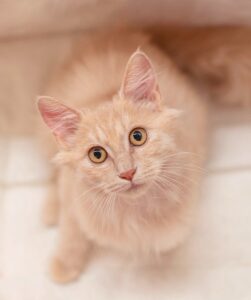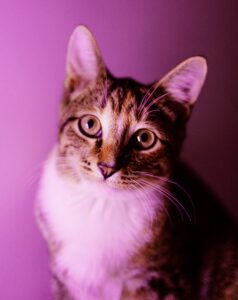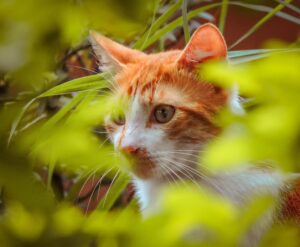 You might be surprised to learn that the answer to this question is no. Cats do indeed see colors, just not all of them!
You might be surprised to learn that the answer to this question is no. Cats do indeed see colors, just not all of them!
Humans and cats both have two types of color receptors in their eyes: cones and rods. The cones handle vision during the day and color perception. Rods tackle what can be seen at night along with the ability to see from side to side and all around (peripheral vision). Each cone detects the wavelengths of light. Humans have three cones and so can generally detect the whole spectrum of light. For a long time, the popular belief among researchers was that cats saw in monochrome, meaning black/white vision, but recent studies show that the cat eye has two cones. It limits the spectrum of light cats can see, but they are, in fact, able to detect color. The two cones allow cats to see colors on the blue and green color spectrum. That means they can distinguish any color between blue and violet, and any color between green and yellow. Cat eyes do not have the cone associated with the red color spectrum, so colors between red and brown are not detectable to them. These colors will look much darker to your cat and in most cases simply resemble black.
 Fooling human researchers for years!
Fooling human researchers for years!
So why have cats fooled researchers into thinking they were color blind for so long? Well, the answer to that question is quite simple: cats do not rely on color detection for their survival. Humans, for instance, will be attracted to red and blue berries rather than green ones, because green, in the case of most berries, indicates that they are unripe, so not ready for human consumption. Cats, on the other hand, primarily rely on their sense of smell to determine if something is safe to eat, a fact that makes the cat’s sense of smell much better and more sophisticated than ours. In other words, your cat will not care if you put the food in a red or a blue bowl, as long as it smells yummy!
If we compare cat and human eyes in terms of rods – the most sensitive visual receptors – the cat eye has a density of rods almost three times that of a human. This explains why your feline friend can see in the dark and with a much broader field of vision than you. Cats also have larger eyes in proportion to their body size, and the path of light from the pupil to the retina is shorter than in humans. This increases the efficiency of the cat eye even further. Their pupils can be opened wider than ours, and to allow vision under especially bright conditions, cats can also close their pupils to a much smaller area than we can. Furthermore, cat eyes are highly tuned to detect rapid movements, guaranteeing them a top position among the expert hunters of the animal world.
 The cat’s third eyelid
The cat’s third eyelid
Another interesting fact about cat eyes is that they have a third eyelid. In addition to the horizontal set of eyelids that humans also have, cats have a third, vertical eyelid located in the corner of each eye toward the center of the face. The third eyelid is white, and you might have noticed it when your cat is half asleep, and the outer eyelids are not completely closed. Having a third eyelid is pretty cool, as it increases protection against dust, insects, and other foreign objects. So, cats may not be as good as we are at detecting detailed visual variation, such as different colors and geometrical shapes, but their exceptional eyes make up for it in other ways.
There is little doubt that cats are fascinating creatures, and hopefully you have enjoyed reading a bit more about how they actually see the world!

